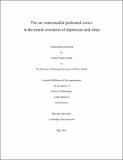| dc.contributor.advisor | Lu, Jun | |
| dc.contributor.advisor | Saper, Clifford B. | |
| dc.contributor.author | Chang, Celene Hyunju | |
| dc.date.accessioned | 2013-09-26T13:54:02Z | |
| dc.date.issued | 2013-09-26 | |
| dc.date.submitted | 2013 | |
| dc.identifier.citation | Chang, Celene Hyunju. 2013. The Rat Ventromedial Prefrontal Cortex in the Neural Circuitries of Depression and Sleep. Doctoral dissertation, Harvard University. | en_US |
| dc.identifier.other | http://dissertations.umi.com/gsas.harvard:10923 | en |
| dc.identifier.uri | http://nrs.harvard.edu/urn-3:HUL.InstRepos:11110430 | |
| dc.description.abstract | Major depressive disorder (MDD) is a debilitating disorder affecting hundreds of millions of people worldwide. The etiology of the disease is unknown, and how antidepressant medications reverse depression is unclear. However, imaging and postmortem studies of MDD patients show abnormalities in several limbic areas of the brain, including the prefrontal cortex. The involvement of the ventromedial prefrontal cortex (vmPFC) in depression has been particularly intriguing, for this region demonstrates reduced metabolic activity in remission, and this reduction is unique to treatment responders. In addition, deep brain stimulation targeting the subgenual cingulate cortex in the vmPFC has been shown to be effective in treating 'treatment-resistant' patients. Furthermore, neuroanatomical studies have shown that this region projects to many downstream limbic areas implicated to play roles in MDD. I therefore hypothesized that 1) the vmPFC may be an important target of antidepressant drugs, and that 2) this region may play a role in the generation of depression-associated behaviors. To test the first hypothesis, I administered desipramine (DMI), a tricyclic antidepressant, to rats. I found that the rat vmPFC was significantly activated by DMI, whereas the dorsomedial PFC (dmPFC) was not. I also found that the drug increases neuronal activity in the nucleus accumbens, but this activation was dependent on the integrity of the vmPFC. To test the second hypothesis, I induced neuronal lesions in the rat dmPFC or vmPFC and subjected the animals to behavioral tests. I found that while lesions in both areas led to increased REM sleep, only vmPFC-lesioned animals had reduced REM latency, increased sleep fragmentation and increased forced swim test immobility. Together, these results demonstrate that the vmPFC may be an important region for both antidepressant action and the generation of depression-like behaviors. | en_US |
| dc.language.iso | en_US | en_US |
| dash.license | LAA | |
| dc.subject | Neurosciences | en_US |
| dc.subject | depression | en_US |
| dc.subject | desipramine | en_US |
| dc.subject | sleep | en_US |
| dc.subject | ventromedial prefrontal cortex | en_US |
| dc.title | The Rat Ventromedial Prefrontal Cortex in the Neural Circuitries of Depression and Sleep | en_US |
| dc.type | Thesis or Dissertation | en_US |
| dash.depositing.author | Chang, Celene Hyunju | |
| dc.date.available | 2013-09-26T13:54:02Z | |
| thesis.degree.date | 2013 | en_US |
| thesis.degree.discipline | Neuroscience | en_US |
| thesis.degree.grantor | Harvard University | en_US |
| thesis.degree.level | doctoral | en_US |
| thesis.degree.name | Ph.D. | en_US |
| dc.contributor.committeeMember | Lee, Chih-Hao | en_US |
| dc.contributor.committeeMember | Mitchell, James | en_US |
| dc.contributor.committeeMember | Hu, Frank | en_US |
| dc.contributor.committeeMember | McCarley, Robert | en_US |
| dash.contributor.affiliated | Chang, Celene Hyunju | |


